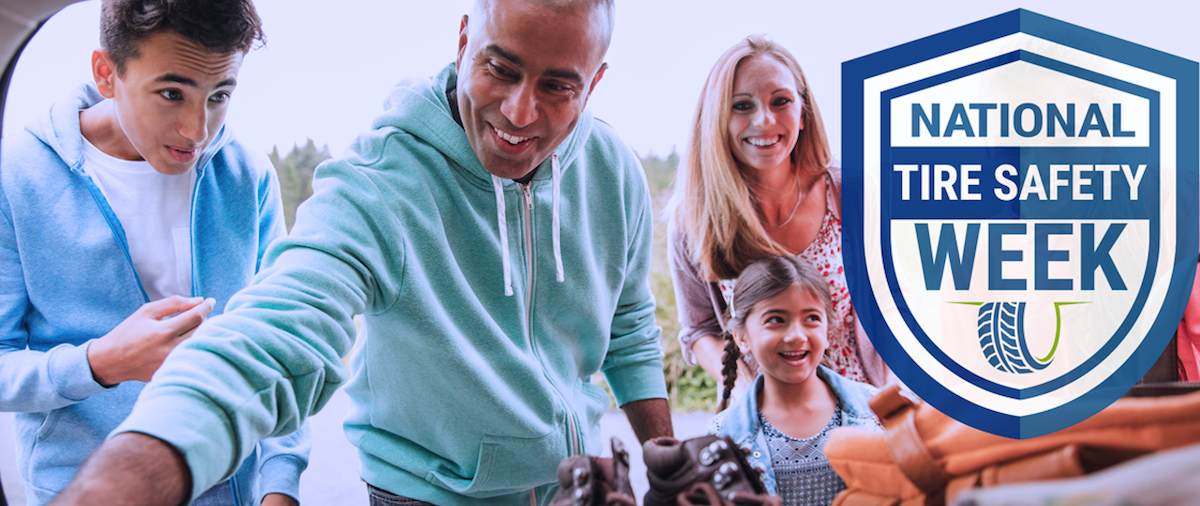Air Bags. Seatbelts. Blind Spot Detection. Cameras. Those were the top responses that continued to come up in a recent poll I conducted. And when I say poll – I’m talking a very informal, unofficial, non-scientific poll via conversations and group text chats with my family, friends, and even some random people standing near me as we pumped gas.
I asked them one simple question: What do you think is the most important (or few most important) components on your vehicle that help ensure your safety on the road? And while those repeat answers above are for sure all extremely essential to keeping us and our passengers (and Broncos!) safe on the road, I was surprised that NOT ONE PERSON SAID TIRES..
I knew National Tire Safety Week was coming up, and something really stood out to me when I was at the U.S. Tire Manufacturers Association (USTMA) website that inspired me to conduct my poll. It said: “Tires are one of the most important safety components of the car and the only part that touches the road and, as such, critical to road safety.” I honestly had never thought about tires that way, and clearly neither have many other people. That makes this annual initiative organized by the USTMA even more important.

Aiming to educate drivers about the importance of proper tire care and maintenance for road safety, the 2025 National Tire Safety Week is happening today through July 4.
We all know that staying on top of the maintenance schedule for our Ford Broncos and Sports is crucial to its performance, reliability, and longevity. And National Tire Safety Week is a great reminder that tire care should be a top priority in those efforts. You can find the maintenance schedule — including some great detailed tire care and maintenance info — in the owner’s manual for your Bronco or Sport.
During National Tire Safety Week, the USTMA reminds drivers that with routine maintenance by a tire service professional, tires can maintain optimum performance and service life. Whether you take your Bronco for intense off-roading on the trails, regularly load it up for family adventures, or mainly use your Bronco for every day driving on the pavement — we all need our tires to keep us safe on the road. To get the most out of your tires and keep them in good working condition, the USTMA recommends these simple steps that can help you play your PART in keeping your tires well maintained and safe.
• Check Inflation PRESSURE Monthly
• Get ALIGNMENT Checked by a Tire Service Professional
• ROTATE Your Tires
• Inspect the TREAD of Your Tires
These may be standard things that are not new to you, but a little reminder/refresher every now and then is important, especially when it comes to your safety.

CHECK INFLATION PRESSURE MONTHLY
Having the correct air pressure in your tires is one of the easiest, but often overlooked, steps in regular vehicle maintenance. However and wherever you drive your Bronco, maintaining proper inflation is crucial, as it ensures optimal tire performance, fuel efficiency, and ultimately, safe operation of your Bronco.
When Should Your Check Your Tire Pressure?
- At least once a month
- Before/After a day on the trails
- Before a long road trip
- When carrying a big load
- During extreme temperatures
- When the Tire Pressure Monitoring System (TPMS) of your Bronco indicates one or more of your tires are low on pressure
It’s important to remember that tire pressure should be checked when the tires are "cold," which means when your car hasn't been driven for three hours or for less than a mile at moderate speed.

Know the Tire Inflation Pressure
Obviously, knowing the recommended inflation pressure is essential for proper — and SAFE — tire inflation. You can find the recommended tire inflation pressure next to the tire size on a label adhered to the B-Pillar or the edge of the driver door.
Watch the Over and Under
Tires need proper inflation pressure to operate effectively and for an extended period of time. And when your Bronco tires have too much or too little air, it can cause them to wear faster (and unevenly), as well as impact the handling, braking performance, and fuel economy of your Bronco.
- Underinflated tires can affect how your Bronco rides, impact the accuracy of the steering, and cause your fuel mileage to worsen. While there are times when drivers will “air down” to hit the trails, on a day-to-day basis you should really try to stay at the recommended inflation pressure.
- Overinflated tires are stiffer and pose some of the same issues, plus others like decreased traction, a rougher/less comfortable ride, increased potential for blowouts, and more.
Those inflation pressure numbers were recommended for a reason, so do everything you can to stay at that level. You can take your Bronco in somewhere to have the pressure checked, or pick up a tire gauge in the Bronco Nation Gear Store and check it yourself anytime. If you haven’t already, you may also want to consider a portable air compressor so you’re ready to air up on the go. And don’t forget, Bronco Nation members save 10% every day in the Bronco Nation Gear Store.
The Weather and Your Tire Pressure
Rapid weather changes and temperature swings can have a quick effect on tire pressure. "For every 10 degrees fahrenheit of temperature change — be it up or down, or hot or cold temps — your tire pressure will change by about 1 psi," said Kyle Stone, our fellow Bronco Nation member and Ford Senior Master Technician. “So if it gets really hot, people should check to make sure their tires aren't over inflated. And if it gets really cold, they should check to make sure they are not underinflated.”
Read more about tire pressure in the Bronco Owner’s Manual.
GET ALIGNMENT CHECKED BY A TIRE SERVICE PROFESSIONAL
If you’re behind the wheel of your Bronco and notice it has suddenly begun pulling to the left or right as you drive, or the steering wheel vibrates or is off-center when driving straight, or if you notice irregular tire treadwear — you should make a service appointment to have your alignment checked. These types of issues are often present when a vehicle’s suspension goes out of alignment.

Photo: Ford Motor Company
A variety of factors can cause your Bronco to go out of alignment. If you love to hit the trails and take your Bronco on off-road adventures, that could definitely play a role. Some of the other most common causes are potholes, driving on rough roads, hitting curbs or objects in the road. Each of these impacts can affect/alter your suspension, causing it to shift from its alignment settings. By correcting these issues and maintaining proper alignment on your Bronco… you’ll be helping to even out the wear and extend the life of your tires.
ROTATE YOUR TIRES
Just as the phrase suggests, rotating your tires means periodically changing the position of each tire on your vehicle. This should be done at regular intervals to maintain the quality and extend the life of your tires (including the spare!).
“People should do a five-tire rotation for full-size tires to maximize the available tire life,” said Kyle. “I recommend a rotation at every 5,000 miles — same interval as an oil change, but every other oil change is also acceptable. Lack of tire rotations can cause tire cupping/chopping over time and cause the tires to be louder and the ride to be rougher.”

Graphic: Ford Motor Company; 2025 Bronco Owner’s Manual
There are several reasons why tire rotations are important and should always be incorporated into your tire maintenance plan to ensure smooth, safe drives in your Bronco.
- Routinely rotating your tires will help all of your tires wear more evenly, providing better tire performance and longer tire life.
- That even wear helps keep the tread depth and the traction consistent across all tires. This will improve performance and keep your Bronco safer for driving overall.
- Regularly rotating your tires provides the opportunity to look at the overall condition of each tire: inspect them for damage, check the air pressure and tread depth, have them rebalanced if needed, etc.
INSPECT THE TREAD OF YOUR TIRES
Ensuring your tires have a decent amount of treads can increase performance and handling of your Bronco. Having enough tread depth is important for grip, as it provides your tires with traction that can help ensure your Bronco is able to stop safely, especially on wet roads.

There are many ways to check the tread depth of your tires. One of the most common/popular (and easy!) ones is called “the penny test”. Just place a penny with Lincoln’s head upside-down in a tread groove. If you can see the top of Lincoln’s head, your tread may no longer be deep enough, and it may be time to replace your tires. Note: When performing the penny test, remember to check each tire AND be sure to check different areas around each tire, paying special attention to spots that look the most worn.
According to the 2025 Bronco Owner’s Manual: “When the tread is worn down to 2/32 inch (1.6 mm), tires must be replaced to help prevent your vehicle from skidding and hydroplaning. Built-in treadwear indicators, or wear bars, which look like narrow strips of smooth rubber across the tread, will appear on the tire when the tread is worn down to 2/32 inch (1.6 mm). When the tire tread wears down to the same height as these wear bars, the tire is worn out and must be replaced.”
Whether you are heading out for that big summer road trip with the family or doing your daily driving close to home, follow these guidelines from the USTMA and get the most out of your tires and keeping them in safe working condition during National Tire Safety Week and beyond.



Comments
You must log in or register to post here.